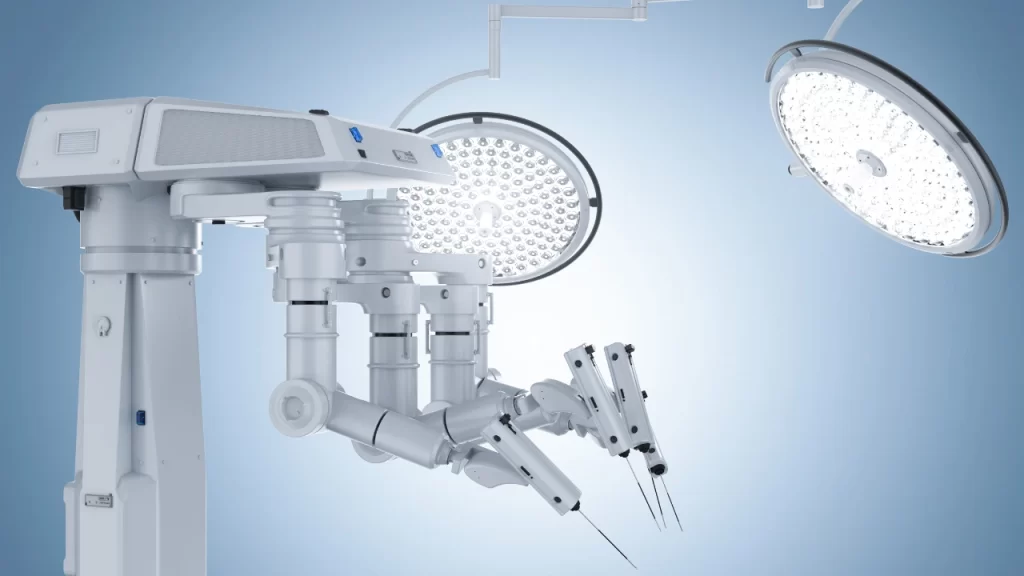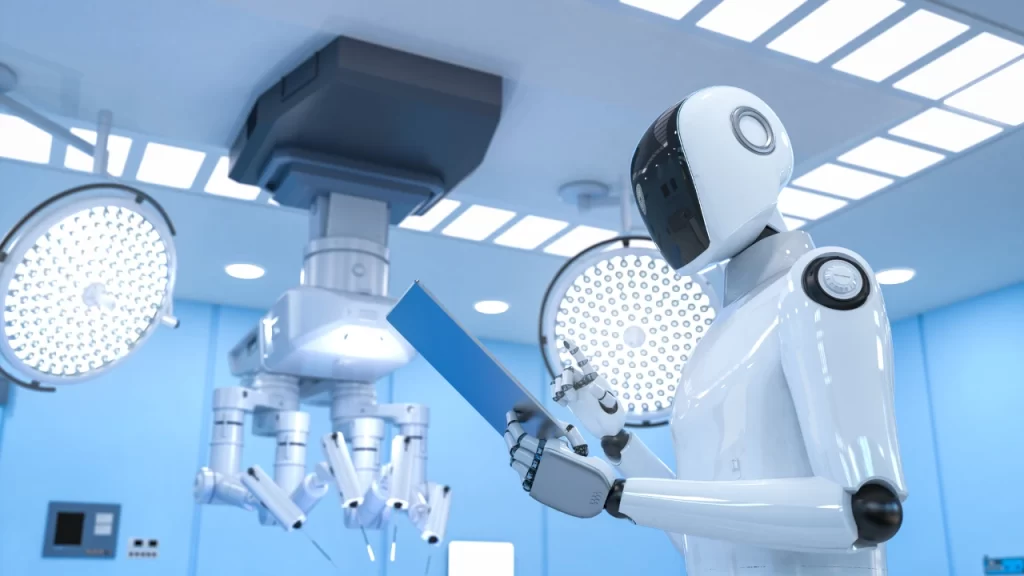Robotic Surgery: How Medical Robots and Healthcare Robotics Are Shaping the Future
A Business Plan Perspective

1. Introduction: The Growing Significance of Robotic Surgery in Modern Healthcare
1.1 The Evolution of Robotic Surgery
Robotic surgery has evolved dramatically over the past two decades, transforming how complex medical procedures are performed. From minimally invasive surgeries to intricate organ transplants, Medical Robots are helping surgeons achieve higher precision and control. Early robotic systems were limited in their capabilities, but today’s Healthcare Robotics technology integrates artificial intelligence, machine learning, and real-time analytics. These advancements are not only enhancing surgical outcomes but also minimizing patient recovery times and hospital stays. As more hospitals and healthcare providers adopt Robotic Surgery systems, the global demand for robotic technologies is steadily rising, making it a lucrative industry for investors and startups.
1.2 Why Robotic Surgery is a Booming Industry
The increasing reliance on Medical Robots is driven by several factors, including the growing elderly population, the rise in chronic diseases, and the global shortage of skilled surgeons. Robotic systems allow healthcare providers to overcome geographical barriers, enabling remote surgeries and virtual consultations. The market for Healthcare Robotics is also being fueled by advancements in AI algorithms, real-time imaging technologies, and IoT-enabled devices. Entrepreneurs and healthcare innovators must understand these dynamics to position themselves strategically in the Robotics in Healthcare Industry. Crafting a robust Healthcare Robotics Business Plan becomes essential to capitalize on these opportunities and secure funding for scalable growth.
2. Business Opportunities in Healthcare Robotics and Robotic Surgery
2.1 Identifying Key Business Models in Healthcare Robotics
Healthcare robotics offers a variety of business models, each catering to a specific need in the healthcare ecosystem. These include manufacturing and selling Surgical Robots, offering robotic-assisted surgical services, developing AI-based diagnostics tools, and providing after-sales training and support. Companies can also explore subscription-based models where hospitals lease robotic equipment instead of purchasing them outright. Each of these models comes with unique revenue streams and scalability potential, but they all require careful planning and analysis. At Digital Vision World, we guide entrepreneurs in selecting the right business model for their Healthcare Robotics Startup Plan to ensure sustainable growth and profitability.
2.2 Niche Markets Within Healthcare Robotics
While Robotic Surgery remains the most prominent application, there are several untapped niches in the Robotics in Healthcare Industry. These include robotic exoskeletons for physical rehabilitation, automated pharmacy robots for medication dispensing, and AI-powered medical imaging systems. Startups entering these specialized fields can carve out a unique market share and differentiate themselves from traditional players. However, these opportunities require a clear understanding of market dynamics, regulatory guidelines, and technological integration. A well-documented Healthcare Robotics Business Plan acts as a strategic guide, helping startups align their vision with actionable steps.
3. Key Components of a Successful Healthcare Robotics Business Plan

3.1 Market Research and Feasibility Analysis
Market research is the foundation of any successful Healthcare Robotics Business Plan. It involves analyzing industry trends, identifying target audiences, assessing competitors, and estimating market demand. Entrepreneurs need to answer critical questions: Who are the primary users of Medical Robots? What challenges do healthcare providers face in adopting robotic systems? How competitive is the local and global Robotics in Healthcare Industry landscape? By addressing these questions, businesses can gain actionable insights that inform product development, marketing strategies, and financial projections.
3.2 Financial Projections and Investment Planning
Investors expect transparency and clarity when evaluating a startup’s potential, which is why financial projections are a critical part of any Healthcare Robotics Business Plan. Detailed financial statements, including profit and loss forecasts, cash flow analysis, and break-even analysis, demonstrate the viability of the business model. Additionally, the plan should outline funding requirements, how the capital will be utilized, and expected ROI timelines. At Digital Vision World, we help healthcare robotics startups create compelling financial projections that attract investors and instill confidence in stakeholders.
4. Investment and Funding Strategies for Healthcare Robotics Startups

4.1 Funding Sources for Healthcare Robotics Startups
Securing adequate funding is often one of the biggest challenges for startups in the Robotics in Healthcare Industry. Fortunately, there are multiple avenues available, including venture capital firms, angel investors, government grants, and crowdfunding platforms. Many global health organizations also provide innovation grants specifically for healthcare technology startups. However, each funding source comes with its own requirements and expectations. A carefully crafted Healthcare Robotics Business Plan can make the difference between attracting a committed investor and missing out on a funding opportunity. At Digital Vision World, we assist startups in identifying the right funding channels, preparing investor pitches, and creating a financial roadmap to maximize resource allocation and return on investment.
4.2 How to Attract Investors with a Strong Business Plan
Investors in healthcare robotics prioritize not only groundbreaking innovation but also a well-defined strategy for long-term profitability and sustainable growth.. A strong Healthcare Robotics Business Plan must include a well-defined problem statement, a unique value proposition, and a detailed growth strategy. Investors are more likely to trust startups with a transparent plan that showcases measurable KPIs, achievable milestones, and an exit strategy. At Digital Vision World, we specialize in designing investor-friendly business plans that address these critical aspects, ensuring startups can secure the funding they need to thrive in the Robotics in Healthcare Industry.
5. Challenges and Solutions in Launching a Healthcare Robotics Business
5.1 Overcoming High Initial Costs and Regulatory Barriers
Launching a Healthcare Robotics startup comes with significant upfront costs, including research and development, regulatory compliance, and market entry expenses. Furthermore, healthcare robotics is a heavily regulated industry, requiring approvals from authorities such as the FDA or CE marking for medical devices. Without proper planning, these costs and regulatory hurdles can quickly become roadblocks. A comprehensive Healthcare Robotics Startup Plan must allocate budgets for compliance, licensing, and legal consultations. At Digital Vision World, we provide businesses with detailed cost structures and guide them through regulatory landscapes, ensuring smooth entry into the market.
5.2 Addressing Adoption Challenges in the Healthcare Sector
Despite the benefits of Robotic Surgery and Medical Robots, some healthcare providers remain hesitant to adopt these technologies due to concerns about costs, staff training, and return on investment. Successful startups in this space must focus on creating value-driven solutions that address these concerns. This includes offering training programs for healthcare professionals, ensuring after-sales support, and demonstrating tangible outcomes through case studies and pilot programs. Our business plans at Digital Vision World include strategies for overcoming these adoption challenges, focusing on education, transparent communication, and building trust with healthcare stakeholders.
6. Future Trends: Robotics in Healthcare Industry and Market Growth

6.1 AI Integration in Robotic Surgery and Medical Robots
The integration of Artificial Intelligence (AI) in Robotic Surgery is one of the most exciting advancements in healthcare technology. AI enables real-time data analysis, predictive diagnostics, and enhanced surgical precision, reducing the margin for human error. Innovations such as AI-powered imaging systems and robotic-assisted telesurgery are already reshaping healthcare delivery worldwide. Startups focusing on AI-integrated Medical Robots have a competitive edge in the market. However, leveraging these opportunities requires strategic planning and investment. At Digital Vision World, we help businesses align their strategies with emerging AI trends in healthcare robotics.
6.2 The Role of Robotics in Remote Healthcare and Telemedicine
The COVID-19 pandemic accelerated the adoption of telemedicine and remote healthcare solutions, and Healthcare Robotics played a vital role in this transition. From remote robotic surgeries to automated patient care robots, the applications are vast and transformative. This trend is expected to grow, especially in underserved regions where access to specialized healthcare remains limited. Startups focusing on remote healthcare robotics must prioritize scalability, user-friendliness, and cost-efficiency in their business plans. At Digital Vision World, we guide businesses in identifying telemedicine opportunities and integrating them into their Healthcare Robotics Startup Plan for long-term success.
7. Conclusion: Why a Solid Business Plan is Essential for Success in Healthcare Robotics
The Robotics in Healthcare Industry holds immense potential for innovation, growth, and profitability. However, entering this market without a clear roadmap can lead to missteps and missed opportunities. A well-crafted Healthcare Robotics Business Plan is not just a document – it’s a strategic tool that guides decision-making, attracts investors, and sets the foundation for sustainable growth. From identifying market opportunities to addressing operational challenges, a strong plan covers every aspect of building and scaling a Healthcare Robotics business. At Digital Vision World, we specialize in creating tailored business plans designed to meet the unique needs of healthcare robotics startups. Whether you’re launching a Medical Robots venture or scaling your existing Robotic Surgery startup, our expertise ensures you’re equipped for success in this competitive industry.
Frequently Asked Questions (FAQ) About Robotic Surgery and Healthcare Robotics Business Plans
Q1: What is robotic surgery, and how is it different from traditional surgery?
A: Robotic surgery is a minimally invasive surgical technique that uses advanced robotic systems, such as Medical Robots, to assist surgeons during procedures. These robots provide enhanced precision, flexibility, and control compared to traditional hand-held tools. This leads to smaller cuts, a lower chance of complications, and quicker recovery times.
Q2: How do Medical Robots improve patient outcomes?
A: Medical Robots improve patient outcomes by reducing human error, enhancing surgical precision, and enabling complex procedures that may be difficult with conventional methods. They also allow for minimally invasive techniques, leading to shorter hospital stays and quicker recovery periods.
Q3: What are the key components of a Healthcare Robotics business plan?
A: A robust Healthcare Robotics Business Plan should include:
- Market analysis and industry research
- Business model and operational structure
- Financial projections and funding requirements
- Regulatory compliance strategies
- Risk management and mitigation plans
- Growth and scalability roadmap
Q4: Why is investment in Healthcare Robotics considered profitable?
A: The Robotics in Healthcare Industry is experiencing rapid growth due to rising healthcare demands, advancements in AI technology, and the increasing adoption of minimally invasive surgeries. Startups and investors can expect significant returns if they approach the market with a well-structured Healthcare Robotics Startup Plan.
Q5: What are the biggest challenges in launching a Healthcare Robotics startup?
A: Key challenges include:
- High initial investment costs
- Stringent regulatory requirements
- Staff training and technology adoption hurdles
- Competition from established players
- Building trust and acceptance in traditional healthcare systems
These challenges can be mitigated with proper planning and strategic execution.
Q6: How can Digital Vision World help in creating a Healthcare Robotics business plan?
A: At Digital Vision World, we specialize in crafting investor-ready Healthcare Robotics Business Plans. Our services include market analysis, financial modeling, operational strategies, and investor pitch preparation, ensuring startups have a clear and actionable roadmap for success.
Q7: What are some emerging trends in Robotic Surgery?
A: Key trends include:
- Use of AI and machine learning in robotic systems.
- Remote robotic surgeries and telemedicine integration
- AI-powered diagnostic robots
- Enhanced robotic-assisted rehabilitation programs
These advancements are revolutionizing healthcare delivery worldwide.
Q8: How can startups secure funding for a Healthcare Robotics business?
A: Startups can secure funding from:
- Venture capital firms
- Angel investors
- Government grants
- Crowdfunding platforms
- Strategic partnerships with healthcare institutions
A well-documented Healthcare Robotics Startup Plan significantly increases the chances of securing financial backing.
Q9: Is the Robotics in Healthcare Industry suitable for new entrepreneurs?
A: Yes, the Healthcare Robotics Industry is ripe with opportunities for innovation and growth. However, entering this market requires careful planning, significant investment, and an understanding of regulatory landscapes. With expert guidance from Digital Vision World, entrepreneurs can confidently navigate this space.
Q10: What is the role of AI in Medical Robots?
A: AI enhances Medical Robots by improving real-time decision-making, enabling predictive diagnostics, and automating routine tasks. This integration allows surgeons to focus on critical aspects of procedures while the AI manages repetitive or data-intensive tasks.
Q11: Are there ethical concerns regarding Robotic Surgery?
A: Ethical concerns include data privacy, patient consent, reliance on machine accuracy, and the potential loss of human touch in medical care. Addressing these issues requires transparency, clear regulations, and patient-focused care strategies.
Q12: How can a startup differentiate itself in the Healthcare Robotics market?
A: Differentiation can be achieved through:
- Developing unique robotic solutions
- Focusing on underserved healthcare niches
- Offering comprehensive training and support programs
- Integrating advanced AI capabilities into products
A clear Healthcare Robotics Business Plan is essential for defining these strategies.
Q13: What types of Medical Robots are most commonly used in healthcare?
A: Common types include:
- Surgical Robots for minimally invasive procedures
- Rehabilitation Robots for physical therapy
- Diagnostic Robots for imaging and analysis
- Telepresence Robots for remote consultations
Q14: What role does regulatory compliance play in Healthcare Robotics businesses?
A: Regulatory compliance ensures that healthcare robotics products meet safety and performance standards. Startups must adhere to guidelines from authorities like the FDA (U.S.) and CE marking (Europe) to gain market approval.
Q15: How does a business plan help attract investors in the Healthcare Robotics sector?
A: A Healthcare Robotics Business Plan demonstrates the startup’s vision, financial feasibility, growth strategy, and risk management approach. Investors are more likely to fund startups with a clear roadmap and measurable milestones.
References
- “The Evidence Behind Robot-Assisted Abdominopelvic Surgery: A Systematic Review”
Authors: Naila H. Dhanani, Oscar A. Olavarria, Karla Bernardi, Nicole B. Lyons, Julie L. Holihan, Michele Loor, Alex B. Haynes, Mike K. Liang.
Published in: Annals of Internal Medicine, August 2021.
Summary: This systematic review evaluates the quality of evidence and outcomes of robot-assisted surgery compared with laparoscopy and open surgery in adults. The study analyzes 50 trials with 4,898 patients, focusing on complications, operative duration, and long-term outcomes.
Link: PubMed Abstract - “Medical-Robotics Startup Mendaera Raises $73 Million for Market Launch”
Published by: The Wall Street Journal, July 2024.
Summary: This article discusses Mendaera, a medical-robotics startup that secured $73 million in a Series B funding round. The company aims to enhance the precision of needle-based medical procedures by integrating ultrasound and robotics. - “Cambridge Surgical Robot Approved by US Regulators”
Published by: The Times, August 2024.
Summary: The article reports on the FDA approval of the Versius Surgical System, a portable surgical robot developed by Cambridge-based CMR Surgical, for gallbladder removal surgeries in adults. - “Intuitive Surgical Results Beat on Growing Demand for Surgical Robots”
Published by: Reuters, July 2024.
Summary: This report highlights Intuitive Surgical’s financial performance, attributing increased profits to the rising demand for its da Vinci surgical robots and a 17% increase in procedure volume. - “A Steady Surgeon”
Published by: Time, August 2024.
Summary: The article covers the FDA approval of the Symani surgical system, the first robot approved for microsurgery, featuring wristed robotic arms that enhance precision in delicate procedures. - “Artificial Intelligence Breakthroughs Create New ‘Brain’ for Advanced Robots”
Published by: Financial Times, July 2024.
Summary: This piece explores how advancements in artificial intelligence are enhancing the capabilities of robots across various fields, including healthcare, by enabling more complex and autonomous functions. - “CMR Surgical”
Source: Wikipedia.
Summary: An overview of CMR Surgical, a company specializing in developing surgical robotic systems, including its history, funding milestones, and product developments. - “MAKO Surgical Corp.”
Source: Wikipedia.
Summary: This entry provides information on MAKO Surgical Corp., known for developing robotic-arm assisted surgical devices, including its history, acquisition by Stryker Corporation, and impact on the medical device industry. - “The Hottest Startups in Zurich in 2024”
Published by: Wired, August 2024.
Summary: The article profiles emerging startups in Zurich, including Nanoflex Robotics, which specializes in robotic platforms for emergency surgery, highlighting the innovation landscape in the region.
Ready to launch your business?
Create unforgettable moments
with our expert guidance
